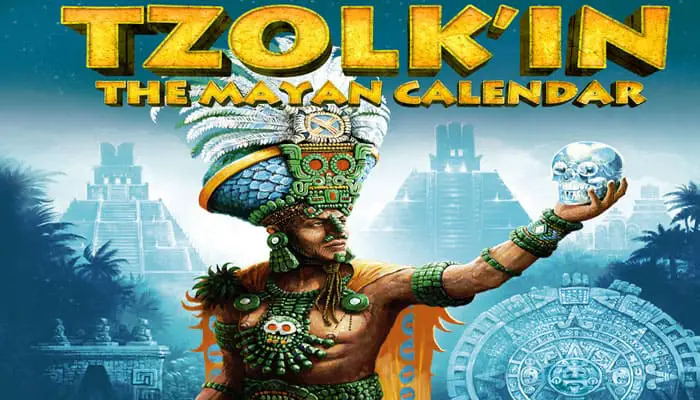
Game Components

- Game Board
- 13 Monuments
- 32 Buildings divived into 2 ages
- 4 two-side player boards
- 1 starting player marker
- 6 gears of various sizes
- 4 scoring counters
- 65 wooden blocks
- 13 crystal skulls
- 65 corn tokens of values 1 or 5
- 28 harvest tiles
- 21 starting wealth tiles
- 1 sheet with stickers
- 6 plastic fasteners
- 24 workers in 4 colors
- 28 markers in 4 colors
Setup
Place the assembled game board in the middle of the table. Lay the rest of the components on or around it as depicted.
Bank
Put all the wood, stone, gold, crystal skulls, and unused workers in a bank where everyone can reach them easily. The corn bank is placed in the middle of the Tzolk'in gear.
Jungle
Associated with the Palenque gear are groups of four spaces representing fields in the jungle that can be cleared and farmed. Place one Corn Harvest Tile on each field.
The group of fields corresponding to Palenque action 2 (the action next to the number 2 written over the corn symbol) can only produce corn, but the other three groups can also produce wood. Put one Wood Harvest Tile on top of each Corn Harvest Tile in the groups corresponding to actions 3, 4, and 5.
Calendar
Rotate the Tzolk'in gear until the arrowhead points at one of the two teeth representing an end-of-age Food Day (the teeth marked by the blue-green stickers).
Starting Player
Give the Starting Player Marker to the player who most recently sacrificed something. In case of a tie, give the Starting Player Marker to the player who volunteers for the next sacrifice.
The Starting Player Marker does not rotate. You can take it by placing a worker on the Starting Player Space, as explained later.
Scoring counter
Each player puts his or her scoring counter on space 0 of the scoring track.
Starting Wealth Tiles
After setting up the game (including revealing buildings and monuments) mix up the Starting Wealth Tiles and deal 4 secretly to each player. Each player chooses 2 to keep and discards the other 2. When everyone has chosen 2 to keep, reveal the players' choices and give them the items depicted on the tiles.
Players keep their Starting Wealth Tiles in front of them; some have an effect that can be used during play.
Player markers
Each player places 7 markers in his or her color: 1 on the white step of each of the 3 temples, 1 on the leftmost space of each of the 4 technology tracks.
Monument Spaces
Deal 6 monuments face up into the monument spaces on the game board. Put the rest of the monuments in the box. You won't need them anymore.
Building Spaces
Deal six Age 1 buildings face up into the building spaces. Place the Age 1 and Age 2 building stacks face down near the game board.
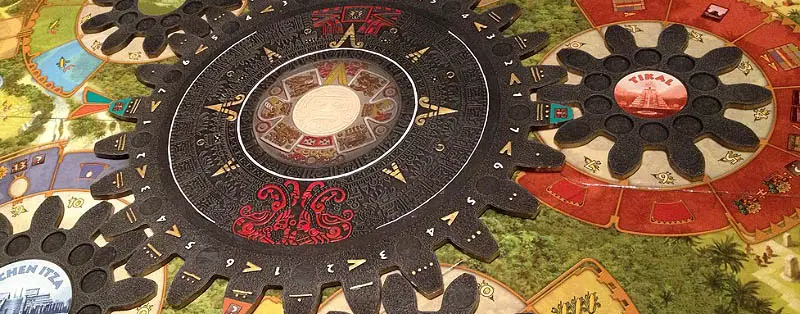
Game Play
Each round of play has 2 or 3 phases:
Players take their turns. Beginning with the starting player and proceeding clockwise, each player takes his or her turn.
On a food day, feed the workers and take rewards. There are only 4 Food Days per game. Most of the time, you will skip this phase.
Advance the calendar. Advance the central Tzolk'in gear - usually only one day. If a worker is on the Starting Player Space, the Starting Player Marker changes hands at this time.
All of these are explained in more detail below.
The game ends after the second age, which corresponds to one revolution of the central Tzolk'in gear. Whoever scores the most victory points is the winner.
Begin with the starting player and proceed clockwise. On your turn you must do one of the following:
- Place any number of workers and pay some amount of corn for that,
- or: Pick up any number of workers from the gears and perform actions.
You must either place workers or pick some up. You cannot skip your turn. You cannot place some workers and pick up others.
Note: Your first turn of the game will always be a placement turn because you have no workers on the gears to pick up.
Begging for Corn
At the start of your turn, if you have 2 or fewer corn, you may beg for corn. To beg for corn, discard all your corn and take 3 from the bank (i.e., take corn from the bank until you have exactly 3). Your foolishness angers the gods and you must step down on one of the three temples.
If you do not have enough corn to place a worker and you have no workers on the gears, then you must beg for corn.
Placing Workers
You begin the game with three workers and you may acquire more during the course of play. You must have at least one available worker (not on a gear and not still in the bank) to place workers.
If you choose to place (instead of pick up) you must put one or more of your available workers onto the gears. You can place multiple workers on your turn, and you may even place all of them.
To place a worker, choose a gear and put one of your available workers on the lowest-numbered unoccupied action space. (The lowest action space is 0).

Example: Red placed a worker on the Palenque gear the previous turn and it is now on action space 1. Now Green wants to place workers on the Palenque gear. The first must go on action space 0 because it is the lowest-numbered unoccupied action space. The second must go on action space 2 because action space 1 is occupied. She wants to place her third worker on Yaxchilan. It must go on action space 0.
Placing workers costs corn:
You pay an amount of corn equal to the number of the action space.
You also pay for the number of workers placed, at the rate depicted on your player board. Note: The boldfaced number is the total cost. The number in parentheses is the cost of adding that particular worker.


Example: When Red places two workers on the Palenque gear, she will have to take action spaces 3 and 4. The first worker costs 3 corn (3 + (+0)) and the second costs 5 corn (4 + (+1)), for a total of 8. Red could afford to place a third worker, but she has no available workers left.
You cannot place more workers than you can afford. You cannot choose to place zero workers. If you must place workers (because you have none on the gears already) and you cannot afford to do so, you must first beg for corn, as described above.
Note: There's also one action space between the Palenque and Chichen Itza gears - the Starting Player Space. You may place a worker there if it is unoccupied, just as though you were placing a worker on an action space 0.
Picking up workers
If you have at least one worker on one of the gears, you may pick up workers instead of placing them. When picking up workers, you remove one or more of your workers from the gears. You may pick up one, some, or all of your placed workers.
For each worker you pick up, do one of the following:
- Use the action where your worker was standing.
- Use a lower-numbered action on the same gear by paying 1 corn for each step back. (You may do this regardless of whether another worker is occupying that lower-numbered action space).
- Do nothing (except pick up the worker).
You perform your chosen actions sequentially. You get to decide the order.

Free Choice Action
The highest numbered action spaces are free choice actions. These are actions 6 and 7 on most gears and action 10 on Chichen Itza. When you pick up a worker from a free choice action space, you may perform any one of the actions on that gear without any extra payment.
Advancing the Calendar
After all players are done with their turns, the Tzolk'in calendar gear is rotated 1 day counter-clockwise. This advances all placed workers 1 action space. A worker that is on the highest numbered action space (7 on most gears, 10 on Chichen Itza) will be pushed off the gear. Return such workers to their owners. Players get no action from workers returned to them this way.
Note: You should use your worker before it is pushed off the gear.
Note: Dummy workers are not pushed off. They stay on the gears for the whole game. This means that sometimes they will be "blocking" an action space with no number.

If no worker was placed on the Starting Player Space this turn, take 1 corn from the bank and put it on the current tooth of the Tzolk'in gear. On the other hand, if there is a worker on the Starting Player Space, the rules for advancing the calendar are different.
Temples
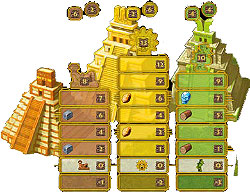
The three gods each have a temple on the game board. Each temple has a different height.
The top step of each temple is in the shape of the god.
The god's symbol marks the white step on which players start the game.
You can climb one step on a temple by:
- Choosing a starting tile that gives you this bonus at the beginning of the game.
- Leaving a crystal skull in Chichen Itza.
- Paying 3 corn on Uxmal action space 1.
- Paying 1 resource block on Tikal action space 5.
- Constructing a building that gives you this privilege.
- Applying a technology that gives you this privilege.
If you receive the privilege of climbing one step on a temple on which you can go no higher, that privilege is wasted.
Note: Uxmal action 1 allows you to move up one step on one temple. Tikal action 5 allows you to move up one step on two different temples. In either case, you can use the action only if you pay the cost (3 corn in Uxmal or 1 block in Tikal). Neither action gives you the option of paying extra to move up extra spaces.
On each temple, the top step can only be occupied by one player. Once a player has reached the top step, no one else can get there (unless that player angers the gods and steps down). All other steps on the temple can be shared.
When you reach the top step of a temple, you immediately place your board lighter-side-up. This can allow you to use the ability to speed up the Tzolk'in gear more than once per game.
(If your board is currently lighterside-up, this benefit is wasted).
Angering the Gods
Certain actions anger the gods, but sometimes you do them anyway because you need the corn. When you anger the gods, you choose one temple and move down 1 step. You cannot choose a temple where your marker is already on the lowest step.
Burn the Forest
On Palenque action spaces 3, 4, and 5, you can burn the forest by discarding a Wood Harvest Tile and taking the Corn Harvest Tile underneath it. This angers the gods and you must move down 1 step in one temple. If you are already at the bottom step of every temple, you cannot burn the forest.
Beg for Corn
If you have 2 or fewer corn at the beginning of your turn, you may beg for corn by discarding all your corn and taking 3 from the bank. This angers the gods and you must move down 1 step in one temple. If you are already at the bottom step of every temple, you cannot beg for corn.
Rare Special Case: At the beginning of your turn, if you have no workers on the gears, then you must place workers. And if you do not have enough corn to place a worker, then you must beg for corn. But if you are already at the bottom step of every temple, then you cannot beg for corn. Do not worry. In this situation, the gods will take pity on you and allow you to place exactly 1 worker. You place the worker on an action space with the lowest possible cost and give all your corn to the bank.
Buildings and Monuments
When you construct a building or a monument, you place it on the table in front of you.
Buildings
When you construct a building, you must deal a new building to replace it at the end of your turn. The new building is from the current age. If all current-age buildings have already been dealt, then the space is left blank.
At the end of Age 1 (halfway through the game) after all players have dealt with feeding workers, remove all Age 1 buildings remaining in the building row and deal out 6 new buildings from the Age 2 stack. That stack will be used for the second half of the game.
Some buildings provide an immediate, one-time bonus. Others, called farms, provide a benefit every time you feed your workers.
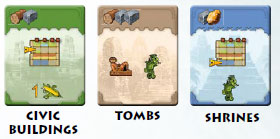
Single-Use Buildings
When you construct one of these buildings, you immediately gain all the bonuses depicted.
Example: When you construct this building, you immediately move up 1 step on each temple and score 3 victory points.
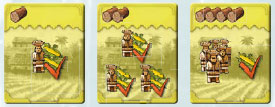
Farms
A farm provides a benefit you can use when it is time to feed your workers.
It is not possible for any worker to require less than 0 corn.
Example: When feeding workers, this player pays 3 corn. Two of her workers require 0 corn, and the others require only 1 corn each.
Monuments

Monuments are dealt only at the beginning of the game. If you construct one, you do not deal out a new monument to replace it.
Monuments have effects that apply only at the end of the game. These effects are depicted on the tile. You may construct more than one monument.
Note that you can construct a monument only with Tikal action 4 and the architecture bonus doesn't apply to it.
Technologies
Technologies make certain actions more valuable for the rest of the game.
There are four technology tracks. Each track has a starting space, three levels of technology, and a bonus space.
If you have reached the third level in a given technology, you cannot advance any more. Whenever you take an action that would advance you on that track, you gain a bonus instead. You can gain this bonus multiple times. If an action allows you to advance twice, you can gain the bonus twice.
A technology affects certain actions. The background color of the technology level corresponds to the color of the actions affected. If your marker is on a higher level technology, you also have the benefits of all the lower level technologies on that track.
Agriculture

1. Take 1 more corn any time you harvest corn from the jungle (Palenque action 2, 3, 4, or 5; but not action 1).
2. If you cannot see any Corn Harvest Tiles on the Palenque action space you're using (i.e. they are hidden under Wood Harvest Tiles or there are no more left), you can still use that action space to get corn (but you do not get a Corn Harvest Tile). Take 1 more corn every time you fish (Palenque action 1)
3. Take 2 more corn any time you harvest corn from the jungle (Palenque action 2, 3, 4, or 5).
4. Immediately move up 1 step on the temple of your choice.
Note: Because bonuses are cumulative, a player with the 3rd level of agricultural technology will get 3 extra corn when harvesting corn from the jungle. He or she can harvest corn even if no Corn Harvest Tile is available on that action. And he or she takes 1 more corn when fishing.
Resource Extraction

1. Take 1 more wood any time you get wood from Yaxchilan (action 1) or Palenque (action 3, 4, or 5).
2. Take 1 more stone any time you get stone from Yaxchilan (action 2 or 5).
3. Take 1 more gold any time you get gold from Yaxchilan (action 3 or 5).
4. Immediately take two resource blocks of your choice.
Note: You get the extra resource only when you acquire a resource of that same type. You can't get a free wood when you harvest corn at Palenque or when you use Yaxchilan action 2.
Note: These technologies only apply to Yaxchilan and Palenque. They do not give you extra resources when you acquire resources in other ways (e.g., from buildings, from the gods, from the Chichen Itza actions, or from the market).
Architecture

1. Take 1 corn any time you construct a building (Tikal action 2 or 4, Uxmal action 4).
2. Score 2 victory points any time you construct a building (Tikal action 2 or 4, Uxmal action 4).
3. When constructing a building at Tikal (action 2 or 4), you may pay for it as though 1 of the resource blocks in its cost was not required. (You choose which block). When constructing a building at Uxmal (action 4) you may pay 2 fewer corn.
4.Immediately score 3 victory points.
Note: When performing Tikal action 4, these technology levels apply to only one of the buildings constructed. The other building (if you choose to build it) costs full price and does not give you any corn or victory points. These technologies do not apply to monument construction.
Theology

1. On the Chichen Itza gear, when you pick up your worker, you may choose to perform the action that is 1 space ahead. You do not pay extra corn to choose this action. This action is instead of any other action the worker could perform.
2. After performing an action on the Chichen Itza gear, you may immediately spend 1 resource block to move up 1 step on the temple of your choice. (If you gained a resource block from your Chichen Itza action, it is available for you to spend in this way).
3. Take 1 more crystal skull any time you get a crystal skull from Yaxchilan (action 4). (Note that this does not apply to crystal skulls you get elsewhere by other means).
4. Immediately take 1 crystal skull from the bank.
Food Days
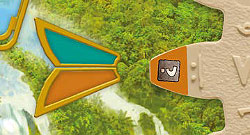
A Food Day is a round in which you must feed your workers. There are 4 Food Days per game.
Four teeth on the Tzolk'in gear are marked as Food Days. When the gear turns so that the arrowhead points to a Food Day (or when a player uses the privilege of the Starting Player Space to skip over a Food Day) the new round is a Food Day. The numbers on the Tzolk'in gear tell you how many days you have until the next Food Day.
Note: The first round of the game is not a Food Day, even though the game starts with the arrowhead pointing to a Food Day. That tooth represents the final Food Day, which happens when the Tzolk'in gear has made one complete revolution.
A Food Day is played like a normal round, except that after everyone has had a turn (and before advancing the Tzolk'in gear) the players must do the following:
Feed the Workers
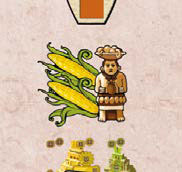
To feed your workers, you must pay 2 corn for each worker you have in play. A worker is in play if it is in front of you or on one of the gears. The only workers not in play are the ones still in the bank.
You must feed as many of your workers as you can. If you fail to feed them all, you lose 3 victory points for each worker that you could not feed.
It is not possible to half-feed a worker. For example, if you have three workers and 5 corn, then you must spend 4 corn to feed two of your workers. You cannot feed the third worker, so you keep 1 corn and lose 3 victory points. Victory points can go negative.
Certain buildings called "farms" allow you to pay less corn to feed your workers.
Change the Buildings Offered
Buildings change from Age 1 to Age 2 at the midpoint of the game.
On the second Food Day, after feeding workers, remove all Age 1 buildings remaining on the game board and deal out six Age 2 buildings to the building row. Monuments are not affected.
Buildings that have already been constructed are not affected.
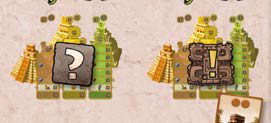
Take Rewards
After everyone has dealt with feeding workers, the temple gods give out rewards to the pious. Rewards take the form of either commodities or victory points, depending on whether the Food Day is at the middle or the end of an age.
Middle-of-Age Rewards
Brown-orange Food Days occur at the middle of an age. These happen at the one-quarter and threequarter marks of the game.
Players are rewarded with resources and crystal skulls. The items you receive depend on your position on the temples. For each temple, you get the resource or crystal skull depicted on your current step, as well as all resources and crystal skulls depicted on lower steps of that same temple.
Note: If the bank does not have enough crystal skulls to reward all the players who should get one, then no one gets a crystal skull.
End-of-Age Rewards
Blue-green Food Days occur at the end of an age. This happens at the midpoint and end of the game. Players are rewarded with victory points.
On each temple, you score the number of victory points indicated by your current step only. Note that if you are on the bottom step, you will lose victory points. Victory points can go negative.
The highest player on each temple receives bonus victory points. The numbers above each temple indicate the amount of the bonus. The lower left number is the bonus at the end of the first age.
The upper right number is the bonus at the end of the game. If multiple players are tied as highest on a temple, all tied players receive half the bonus.
End of the game
The game ends after the fourth Food Day. The Tzolk'in gear will have made one complete revolution. Players convert all of their commodities to victory points and score their monuments.
Then the player with the most points wins.
In case of a tie, whoever has the most workers left on the gears wins. If it is still a tie, then all tied players win.
Esoteric Note: Technically, the Tzolk'in gear advances one more day after the end-of-Age-2 scoring and before the final scoring. This might push workers off the gears, which could affect the tiebreaker.

Final Scoring
To score your final victory points, do the following:
- Convert all resources to corn using the exchange rate for the market.
- Score 1/4 victory point for each corn.
- Score 3 victory points for each crystal skull you still have.
- Score your victory points from your monuments.
Continue Reading

